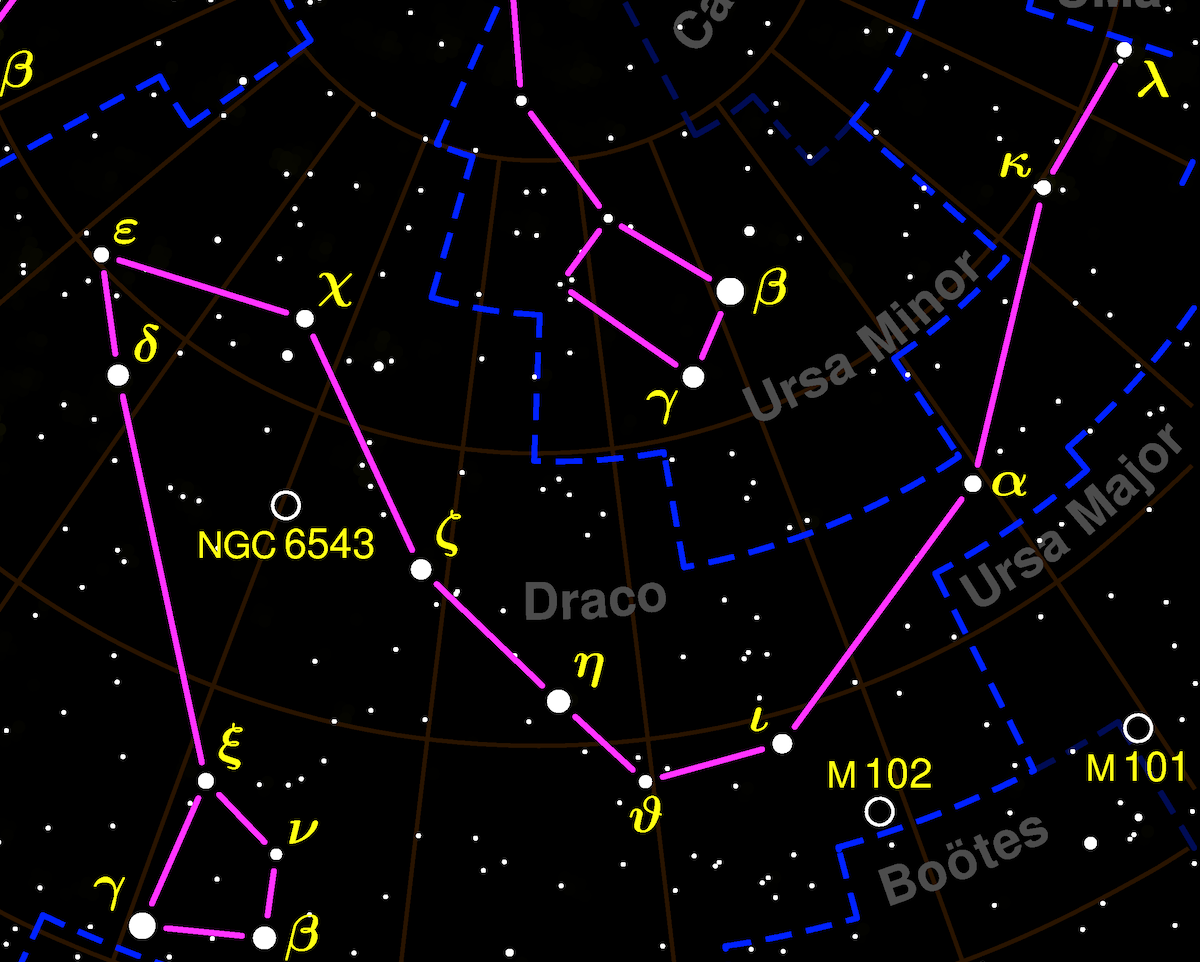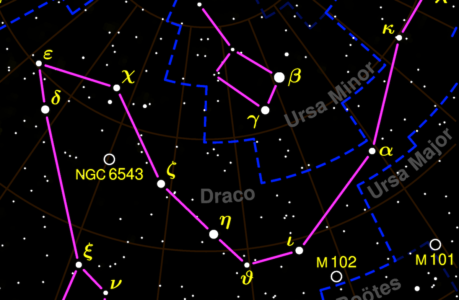The constellation of Draco, named after the Latin word for dragon, is one of the most intriguing and recognizable constellations in the northern hemisphere. Its distinctive shape is made up of several stars that create the image of a dragon snaking its way through the sky. For centuries, this constellation has captured the imaginations of people around the world, from ancient civilizations to modern astronomers.
If you’re based in Ireland and are interested in observing this celestial wonder, you’re in luck! In this article, we’ll take you on a journey to explore the constellation of Draco, and offer tips on how to observe it from the Emerald Isle.
The History and Mythology of Draco
The constellation of Draco is steeped in ancient history and mythology. In Greek mythology, the constellation is said to represent Ladon, a dragon that guarded the golden apples in the garden of the Hesperides. According to the myth, Hercules was tasked with retrieving the apples as one of his twelve labors, and he ultimately defeated Ladon.
The dragon also has significance in Chinese mythology, where it is known as the Azure Dragon of the East. It is believed to be a symbol of power, prosperity, and good fortune. In Hindu mythology, the constellation is associated with the serpent king Vasuki, who played a crucial role in the churning of the ocean of milk.
Draco has been known to astronomers since ancient times, with mentions in the works of Ptolemy and other early astronomers. Its stars have been used as navigational aids and in astrological readings for centuries.
Viewing Draco from Ireland
Draco is visible from Ireland throughout the year, but its position in the sky changes depending on the season. In the summer months, the constellation is high in the sky and easy to spot. In the winter, it is lower on the horizon and may be more difficult to observe.
The best time to observe Draco is during the summer months, when it is visible in the northern sky. To locate it, look for the bright star Vega, which is part of the constellation Lyra. Draco is located between Vega and the North Star, Polaris.
Draco’s distinctive shape makes it easy to identify, with its head and neck forming a distinct triangle. The body of the dragon curves around in a series of loops, creating a dramatic and striking image in the night sky.
If you’re looking to observe Draco from Ireland, the best way to do so is by finding a dark and clear location away from light pollution. The countryside and rural areas are often the best places to observe the night sky, as they offer the least amount of light pollution.
You can also use a telescope or binoculars to get a closer look at the stars that make up the constellation. This can help you to identify individual stars and appreciate the unique features of each.
Draco is one of the most recognizable and fascinating constellations in the night sky. Its rich history and mythology make it a beloved object of fascination for people around the world. If you’re based in Ireland, you have the opportunity to observe this celestial wonder throughout the year. With a bit of knowledge and preparation, you can experience the magic of Draco and appreciate the beauty of the night sky.
How can I see the constellation of Draco from Ireland?
To see the constellation of Draco from Ireland, you need to know when and where to look in the night sky. Here are some steps to help you locate and observe Draco:
- Check the Time of Year: Draco is visible from Ireland throughout the year, but its position in the sky changes depending on the season. The best time to observe Draco is during the summer months, when it is visible in the northern sky.
- Find a Dark Location: To get the best view of Draco, you need to find a dark location away from light pollution. The countryside and rural areas are often the best places to observe the night sky, as they offer the least amount of light pollution.
- Locate Vega: Look for the bright star Vega, which is part of the constellation Lyra. Draco is located between Vega and the North Star, Polaris.
- Identify Draco’s Shape: Draco’s distinctive shape makes it easy to identify, with its head and neck forming a distinct triangle. The body of the dragon curves around in a series of loops, creating a dramatic and striking image in the night sky.
- Use a Telescope or Binoculars: You can also use a telescope or binoculars to get a closer look at the stars that make up the constellation. This can help you to identify individual stars and appreciate the unique features of each.
Remember to dress warmly and bring any necessary equipment, such as a telescope or binoculars, to make your viewing experience more enjoyable. With a bit of knowledge and preparation, you can experience the magic of Draco and appreciate the beauty of the night sky from Ireland.
The mythology of the constellation of Draco
The constellation of Draco, named after the Latin word for dragon, has a rich mythology that has been passed down through various cultures and civilizations over time.
In Greek mythology, the constellation is associated with the story of Ladon, a dragon that guarded the golden apples in the garden of the Hesperides. The story goes that Hercules was tasked with retrieving the apples as one of his twelve labors, and he ultimately defeated Ladon.
In Chinese mythology, the constellation is known as the Azure Dragon of the East and is one of the Four Symbols that represent the cardinal directions. The Azure Dragon is believed to be a symbol of power, prosperity, and good fortune.
In Hindu mythology, the constellation is associated with the serpent king Vasuki, who played a crucial role in the churning of the ocean of milk. According to the myth, the gods and demons were in a battle for the elixir of immortality, and Vasuki was used as a rope to churn the ocean. As a result of his contribution, Vasuki was honored by being turned into a constellation.
In Babylonian mythology, the constellation was known as Tiamat, the goddess of chaos and the sea. The constellation was said to represent the tail of the serpent that Tiamat transformed into after being defeated by the god Marduk.
In many cultures, the dragon is a symbol of power, strength, and good luck. The constellation of Draco has long been associated with these characteristics and has been used for astrological readings and as a navigational aid for centuries.
Today, the constellation of Draco continues to inspire and fascinate people around the world, and its mythology continues to be passed down through the generations.
The Stars in the constellation of Draco
The constellation of Draco is home to several bright stars, including Thuban, the former pole star, and several other stars that make up the dragon’s distinctive shape.
Thuban, also known as Alpha Draconis, is the brightest star in the constellation and was once used as the North Star, serving as a navigational aid for ancient mariners. However, due to the precession of the equinoxes, the North Pole has shifted, and Thuban is no longer the pole star. It is a binary star system with a companion star that orbits around it every 51 days.
Another notable star in Draco is Eltanin, also known as Gamma Draconis. It is the second-brightest star in the constellation and is located near the dragon’s head. Eltanin is also a binary star system, with a companion star that orbits around it every 1,200 years.
Other stars that make up the distinctive shape of Draco include Rastaban, Thuban’s neighbor and Beta Draconis, which is a triple star system. There are also several other stars in the constellation that are visible to the naked eye, making Draco an easy constellation to spot in the night sky.
In addition to these bright stars, Draco is also home to several deep-sky objects, including the Cat’s Eye Nebula, a planetary nebula located in the dragon’s head, and the Draco Dwarf Galaxy, a satellite galaxy of the Milky Way located in the dragon’s tail.
Overall, the stars and deep-sky objects in the constellation of Draco offer a wealth of opportunities for observation and exploration, and are a testament to the beauty and wonder of the night sky.
Deep sky objects visible in the Constellation of Draco
The constellation of Draco is home to several fascinating deep-sky objects that are popular targets for amateur and professional astronomers alike. Here are some of the most notable deep-sky objects visible in Draco:
- Cat’s Eye Nebula: The Cat’s Eye Nebula, also known as NGC 6543, is a planetary nebula located in the dragon’s head. It is a bright and colorful object, with intricate and complex patterns of gas and dust that have been shaped by the dying star at its center.
- NGC 5866: Also known as the Spindle Galaxy, NGC 5866 is a lenticular galaxy located in the tail of Draco. It is notable for its thin, spindle-like shape, which is the result of its orientation relative to our line of sight.
- NGC 5907: The Splinter Galaxy, also known as NGC 5907, is a spiral galaxy located just outside the boundary of Draco. It is a beautiful and intricate galaxy, with a thin, elongated shape and a prominent dust lane that runs through its center.
- Abell 2218: Abell 2218 is a galaxy cluster located in the head of Draco. It is one of the most distant objects visible to amateur astronomers, with a redshift that indicates it is located more than 2 billion light-years away.
- NGC 6543: Also known as the Blue Planetary, NGC 6543 is a planetary nebula located in the head of Draco. It is named for its distinctive blue color, which is caused by ionized oxygen atoms in the nebula.
Overall, the deep-sky objects in Draco offer a fascinating glimpse into the complexity and beauty of the universe. Whether you are a seasoned astronomer or just starting out, observing these objects can be a rewarding and awe-inspiring experience.

